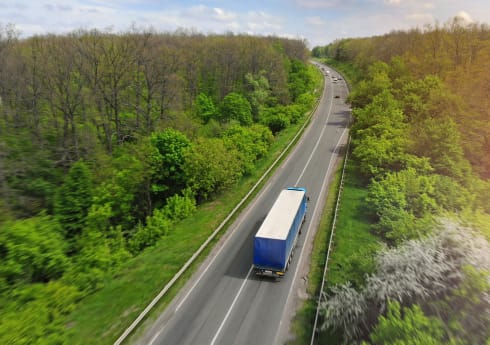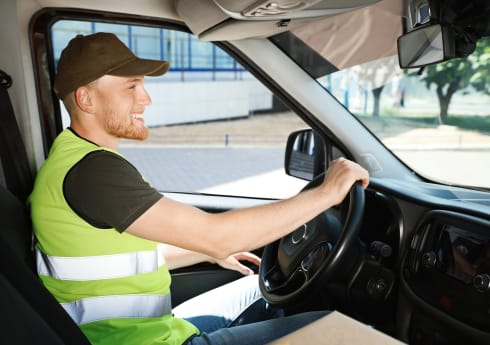Mileage Allowance for Self-Employed
Self-employed workers (sole traders) can cover thousands of miles every year while running their businesses. Whether you work as a courier, pick up supplies or visit sites to quote for jobs; business journeys can amount to a lot of money.
Luckily, you can claim some of these expenses back based on your mileage. Just remember that claiming mileage allowance can be done for business trips only and never for personal journeys. Otherwise, it can be considered tax evasion and have serious consequences.
We compare a range of fleet telematics systems that are industry standard, Thatcham S7 and police-approved (Secured by Design) to help protect your business. Compare now to get the best deals on vehicle tracking.

What is mileage allowance?
In simple terms, self-employed mileage allowance is an amount set by HMRC that a sole trader can claim for using their personal vehicle for business purposes.
As self-employed, you can claim travel expenses in two ways:
1. Based on actual vehicle expenses
Using actual vehicle costs you can claim part of the total cost of running your vehicle, including fuel, insurance, repairs and maintenance, parking, and more.
You’ll need to record all of your business-related vehicle expenses. Add the total from your receipts and you can deduct the costs from the company’s taxable profit at the end of the tax year.
This method is more time consuming and can prove to be a hassle as you have to keep a lot of records. It’s only worth it if you have really high vehicle expenses.
2. With simplified expenses
Using the simplified expenses method set up by the government you can claim mileage allowance at a flat per-mile rate.
It’s a great method for claiming mileage expenses when you want to save time and avoid logging every single penny you’re spending for business trips. You use a flat rate set by HMRC to calculate your vehicle expenses. This flat rate is meant to cover vehicle costs like fuel, insurance, road tax, repairs and maintenance, depreciation, etc.
This is the simplest method to claim self-employed mileage allowance.
iCompario tip:
Claiming mileage expenses doesn’t mean you can’t claim other travel expenses as well. Train tickets, taxi rides, even parking fees paid for business purposes can be claimed as business expenses.
However, you cannot claim vehicle maintenance, insurance, road tax or fuel separately as these are covered by the mileage allowance.
How much is the mileage allowance for self-employed people?
The government sets a flat rate per mile for cars, goods vehicles (like vans) and motorcycles. Of course, there are some exceptions.
For example, cars designed for commercial use, like black cabs, hackney carriages or dual control driving instructors’ cars cannot claim mileage allowance under the simplified expenses scheme.
The flat rate applies as follows:
- For the first 10,000 miles, cars and goods vehicles get 45p per mile.
- After 10,000 miles, cars and goods vehicles get 25p per mile.
- Motorcycles get 24p per mile, regardless how many miles they rack up.
Assuming you’ve covered 12,000 miles over the year on business trips, you calculate your mileage allowance as follows:
- 45p for the first 10,000 miles, which means 10,000 x 45p = £4,500
- 25p for the miles driven after the first 10,000, which means 2,000 x 25p = £500
That means you can claim a total of £5,000.
iCompario tip:
If you’re travelling with passengers on business trips, you can claim a further 5p per mile for each additional passenger. The passengers need to work for your business though.
What can be claimed as self-employed mileage allowance?
You can claim business mileage on journeys that are necessary for work reasons only.
You can also claim mileage allowance for trips made to see a customer or a supplier, or to visit a site for a quote, for example. But if you want to claim mileage allowance as self-employed for commuting to work if you work on a fixed arrangement at the client’s premises, you’re out of luck.
That’s classified as ordinary commuting by HMRC.
Scenarios:
- You’re a self-employed hairdresser and choose to provide your services at the customer’s address. In this case, you can claim the mileage for these trips as a travel expense. However, if you decide to rent a chair at a salon, this is considered your permanent workplace and you cannot claim mileage for the trips between your home and the salon. But you can claim mileage for when you’re off to get supplies.
- You’re a self-employed painter and you keep your tools in a garage, instead of your home. You cannot claim mileage for trips between your home and the garage. But you can claim all the mileage for trips to your customers.
iCompario tip:
If you’ve already claimed capital allowances for a vehicle or included it as an expense when you worked out your business profits, then you cannot claim simplified expenses for that vehicle. Once you use the flat rates for a vehicle, you must continue to do so as long as you use that vehicle for your business.
How to claim mileage allowance if you’re
self-employed?
First thing to keep in mind is that you can use the simplified expenses to claim mileage allowance for self-employed provided you make less than £85,000 per tax year. If your business turnover is more than that amount, you’ll need to use the more difficult way and, probably, an accountant.
Some self-employed workers simply estimate their business mileage and claim a percentage of their vehicle’s total annual mileage. You’d still have to show that those miles were driven for business purposes, if need be.
Logging your business mileage could ease the way you work out and claim your self-employed mileage allowance.
On the other hand, it can be annoying to record every single business trip, especially if you make multiple trips a day. One option that can come in handy is tracking your vehicles using a fleet telematics system.
How can telematics help self-employed people?
Self-employed workers can sometimes feel that telematics is a solution for big companies and therefore fail to see how it can help them.
Telematics comes in various packages to cover a wide range of needs, from sole traders who use one vehicle to large fleets and telematics benefits are more than you can imagine.
Tracking your vehicle can save you lots of time and money.
- Optimise your routes. If you’re a sole trader who drives a lot for business reasons, you can improve your routes to avoid getting stuck in traffic or to avoid clean air zones if you’re not keen on paying those charges. Route optimisation will also save you fuel.
- Secure your vehicle. Your vehicle can be a real asset to you, so knowing its location at all times can be beneficial. Having a telematics device installed also increases the chances of recovering your vehicle in case of theft.
- Reduce costs. Telematics systems can help with cutting down some costs. First, route optimisation means saving fuel. And with the rising fuel prices, that’s a clear goal. Second, some insurance companies might offer better premiums for tracked vehicles.
- Easy access to data. With a telematics solution, you can easily access your journey data. You won’t have to log every business trip you’re taking. You’ll be able to see and pull the data at your convenience.
- Fuel card integration. You can use fuel cards too. This will make it easy to find all your fuel expenses in one place, saving you time on admin so you can focus on other important business aspects.
There’s a variety of telematics solutions on the market, from simple self-install devices to advanced solutions that allow the tracking of huge fleets. For a better understanding on telematics, check out our telematics guide for businesses.
Self-install telematics devices might be better suited for self-employed workers than other options. Benefits include:
- You can install them yourself so there’s no downtime waiting for a professional to get the job done.
- You have access to simple software, where you can easily access all the relevant information.
- They are low cost and you get further discounts if you choose longer subscriptions.
- They include an extensive range of features such as: live location, journey history, location alerts, driver app, and speeding reports.
How iCompario can help
We’re experts at scouring the market and finding the best deals. We’ll save you time and do the heavy lifting. All you have to do is fill in a form, give us some details about your business needs and we’ll make sure to find you the right telematics solution.

